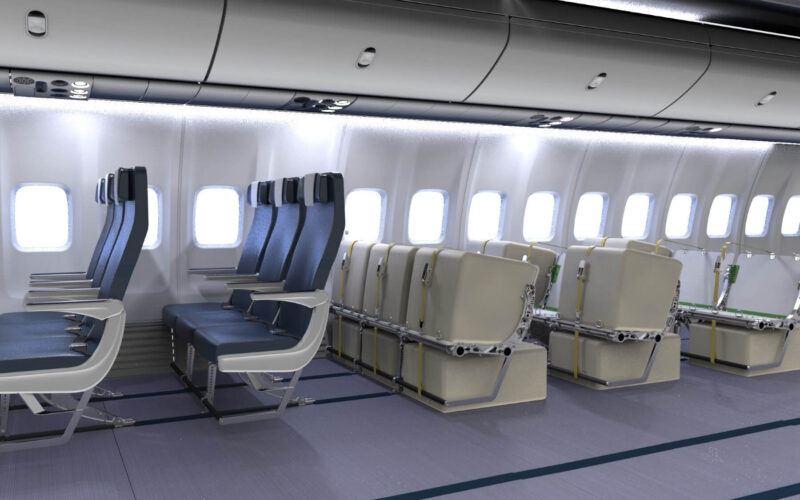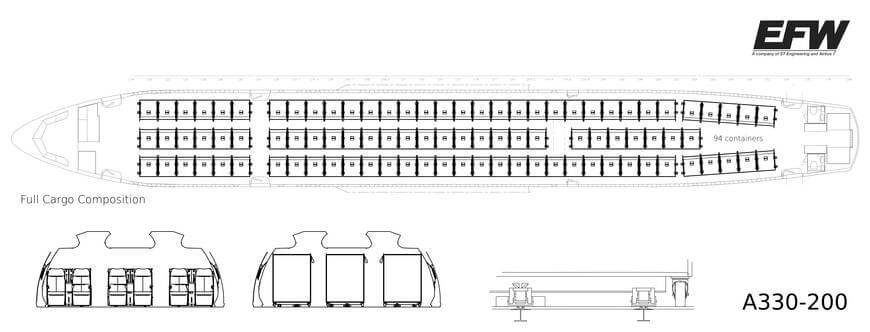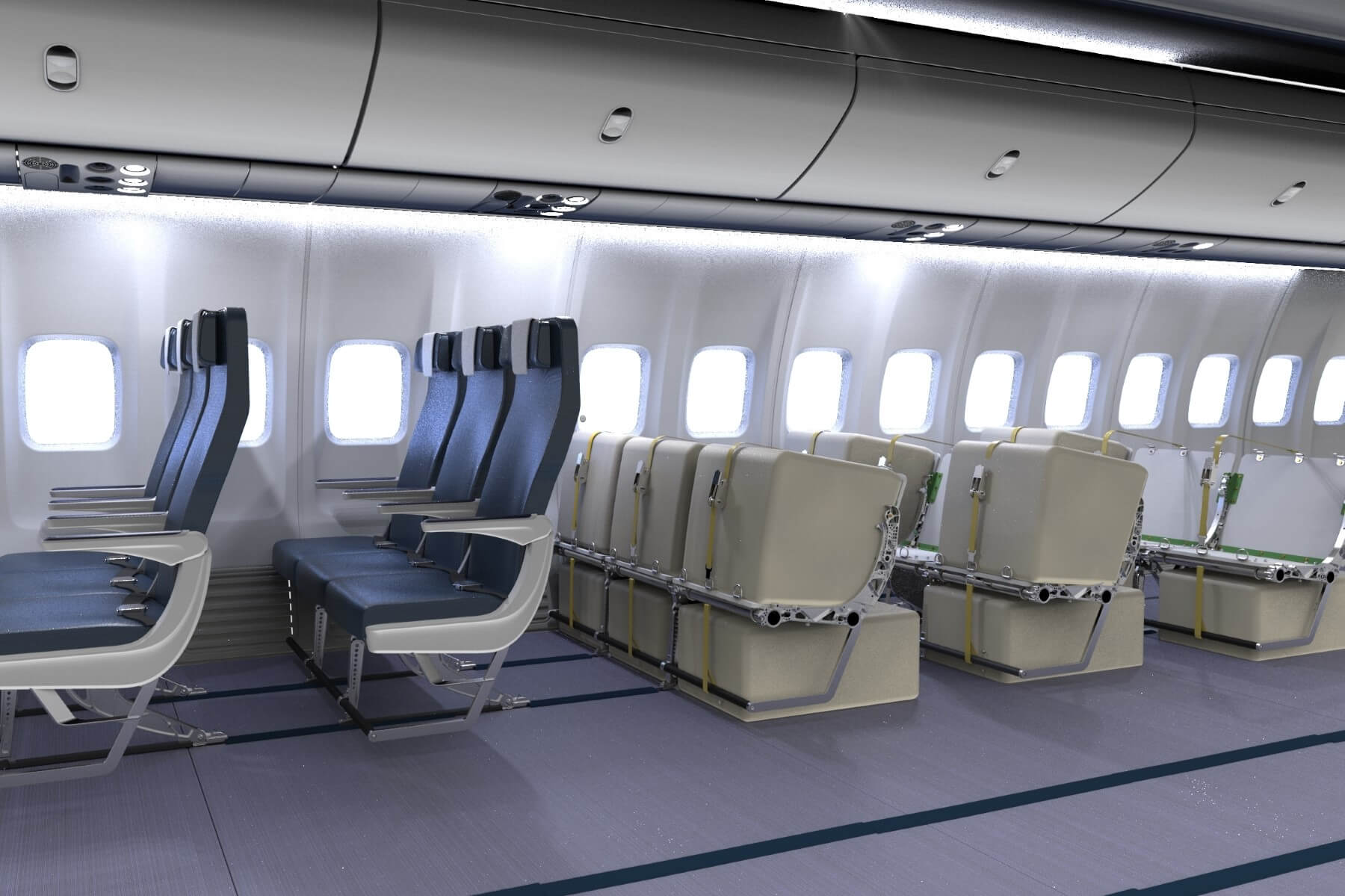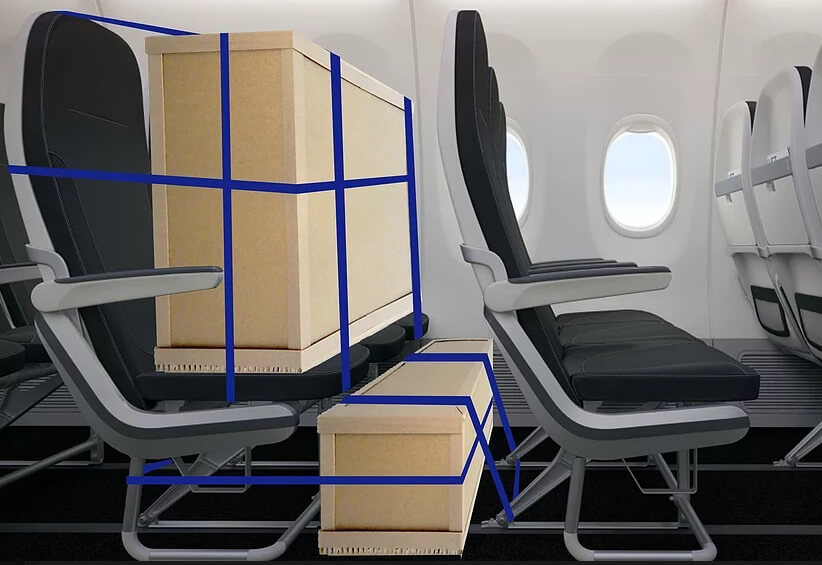While stuffing cargo into the belly of an aircraft is a relatively easy job, passenger cabin loading is a much more complex process, requiring additional technical solutions and regulatory approvals. But with airlines increasingly retrofitting their cabins to carry goods instead of travelers in order to increase cargo capacity, AeroTime shines a light on the most popular COVID-19-inspired innovations used for freight carriage in the passenger plane cabin.
Removable cargo containers with smoke detectors
Removable cargo containers installed in aircraft passenger cabins in just 24 hours are one of a number of solutions devised by carriers seeking to repurpose the cabin to transport cargo goods during the pandemic. For example, Colibri Aero, a Lithuania-based supplier of aircraft parts and interior refurbishments has introduced temporary removable containers, allowing the company to carry freight inside the passenger cabin of wide-body planes, such as Airbus A330s, A340s, Boeing 767s, and Boeing 777s.
The cargo container model is certified by the European Aviation Safety Agency (EASA) and comes in five different sizes, providing a wide selection of capacity for customers. Each container is equipped with a separate smoke detector and has a maximum capacity of around 850 kilograms (1873 lbs) of freight. A typical Airbus A330-200 passenger aircraft cabin can fit 36 containers on board, meaning that this innovation provides airlines with an opportunity to carry as much as 27 tonnes (58,640 lbs) of cargo per single flight.
Once a cargo-only or part-cargo flight is completed, complete container removal and reinstallation of passenger seats can take up to 24 hours, according to the manufacturer. It means that the technology allows airlines to serve both passenger and cargo flights within the same week, adapting to the actual demand.
According to Colibri Aero, the price for a full passenger cabin conversion package (when all seats of a cabin are replaced by removable containers) varies depending on the aircraft type and the number of containers necessary. For instance, the price for a standard Airbus A330-200 passenger plane cabin may be between $1 million and $1.2 million, including container production, engineering, and the supplemental type certificate costs.
Colibri Aero
Cabin Cargo Boxes
Another flexible cargo storage concept introduced amid the pandemic is the Cabin Cargo Box, a lightweight solution designed to help carriers boost cargo capacity for the main jet cabin to its maximum without the need to convert the passenger aircraft into a freighter. The Cabin Cargo Box was launched by German aerospace manufacturer EFW in July 2020.
A single Cabin Cargo Box, which has already received a green light from the EASA and can receive Supplemental Type Certification (STC) if needed, may be loaded up to 200 kilograms (440 lbs) of goods, with a tare weight of 28 kilograms (61 lbs) per container. The passenger cabin of a standard-configured Airbus A330-200 aircraft can carry 94 Cabin Cargo Boxes, loaded in the side-by-side principle of three containers in a row. It equals nearly 19 tonnes (41,887 lbs) of freight per flight in addition to the capacity of the plane belly if counted on the A330-200 jet.
EFW
In order to accelerate freight loading and unloading processes, the manufacturer installed wheels and latches which are designed to perfectly match the seat rowing system in the passenger cabin of both narrow and wide-body aircraft. To help airlines carrying large-sized cargo in the cabin, EFW offers the box in two versions. Freight can be completely closed by the container’s solid door or can be left partly opened with one side of the box locked with nets.
EFW
In-seat package stowage systems
Sometimes it’s not necessary for carriers to remove seats from aircraft cabins in order to create space for freight containers. The Hong Kong-based aircraft engineering group HAECO was one of the first providers to launch a special in-seat stowage system, allowing airlines to hold packages loaded with freight on passenger seats in order to carry more goods during each flight.
Alaska Airlines became a launch customer of this technology in December 2020 when it installed the new in-seat stowage system on three Boeing 737-900 passenger jets, which were used to support a peak of shipping demand. The technology allows loading the aircraft with 6,123 kilograms (13,500 lbs) of freight in the passenger cabin in addition to the available payload of 7,484 kilograms (16,500 lbs) in the belly hold.
According to HAECO, at least two cargo load agents are needed to supervise the cabin loading process, provide fire suppression if required, and make sure that the freight is safe and secure within the in-seat package stowage system.
HAECO
Cabin Cargo Containers
Lufthansa Technik has also introduced a reversible solution for airlines, which aims to use passenger plane cabins for cargo transport without the need for huge investment or inefficient loading processes. Lufthansa Technik created introduced the Cabin Cargo Container (CCC), a specially created and easily loaded container, allowing passenger planes to temporarily convert into freighters.
According to the manufacturer, the concept of a Cabin Cargo Container is to turn a passenger cabin into a full class F cargo compartment, which is not limited in size and which provides the means to control or extinguish a fire without requiring a crew member to enter the compartment. The CCC containers are part of the unique Lufthansa Technik cabin cargo loading system, which offers a comprehensive way of using passenger cabins for freight operations. The innovation allows airlines to modify their aircraft reversible, meaning that the jet can still be used for passenger flights again if necessary.
Lufthansa Technik
Lufthansa Technik says that the design of this container means it can fit through the passenger door of most types of wide-body aircraft, including Airbus A330s, A340s, and Boeing 777s, and adds similar cargo capacities as full Passenger to Freighter (P2F) aircraft conversions without the help of specialist P2F conversion companies. However, the CCC container cannot be loaded into any narrow-body aircraft cabins.
Lufthansa Technik
The SeatBox
With its design of ‘The SeatBox’, Dubai-based MV Aviation became another company to sell reusable seat boxes.The firm’s seat boxes are customized to carry cargo in any configuration of the passenger cabin, including Economy, Premium, Business, and even First Class.
The SeatBox containers are made out of 100% recycled cardboard, which is considered a progressive solution for replacing plastic in the aviation industry. According to MV Aviation, the sides, bottom, and top of the seat boxes are made of Honeycomb cardboard, while the corners are manufactured of high-density cardboard. In order to make The SeatBox sturdy, the corners connecting the top and bottom panels are assembled with a special machine.
MV Aviation
The installation of a single box in a passenger cabin takes up to a minute. During the flight, the boxes are equipped with certified C172 straps. The manufacturer claims that every container is designed depending on specific customer needs, suggesting that the novel product of MV Aviation can vary in terms of cargo volume in each box.
Seat bags
Aerospace manufacturing companies were not the only ones to experiment with new concepts of cabin solutions during the pandemic. Dutch airline KLM is among dozens of other carriers which have been delivering cargo-in-cabin flights since early April 2020. Due to a significantly increased demand for flying medical goods and Personal Protective Equipment (PPE) since the beginning of the pandemic, KLM Royal Dutch Airlines partnered with its long-time supplier company Trip & Co and designed seat bags.
The removable seat bags were designed for loading cargo goods into the cabins of KLM Boeing 777 jets. The airline notes that the product was designed specifically for KLM needs and claims that its design not only minimizes the risk of damaging the plane’s interior, seats, and entertainment systems but also doubles the loading capacity of the cabin.
Introducing Cargo Seat Bag! Yesterday we carried out the first operational flight using 172 Cargo Seat Bags, designed in collaboration with Trip & Co. We carried 950 boxes of medical relief goods from Shanghai to Amsterdam in the cabin of our Boeing 777. #KLM #CargoInCabin pic.twitter.com/KsC86gWg1O
— KLM (@KLM) April 14, 2021
Seat bags, which have been approved by the Dutch Civil Aviation Authority, are made in three different versions and can be installed for single, double, and triple-seat cabin configurations. According to KLM, a set of 172 cargo seat bags can be installed in the passenger cabin of a Boeing 777 jet.
A ‘glide blanket’
While some innovations help airlines to increase cargo capacity while flying freight with passenger aircraft, another concept, called a ‘glide blanked’, has been developed to make the loading process aboard passenger planes easier.
Typically, goods loaded into a passenger plane’s cabin are lifted manually by loaders because none of the mechanical equipment used for freight loading into cargo jets can be used for passenger aircraft. If the loading or unloading is delayed, the aircraft and crews have to wait, thereby affecting their tight schedules. This is the reason why a team of loaders working at Shanghai Pudong International Airport (PVG) in China found a way to shorten – and facilitate – their physically demanding job.
The team invented a smart device designed for passenger planes that have shifted to freight service during the pandemic. The product, comprising a soft blanket with wheels, is said to shorten the usual time for cargo loading into passenger aircraft cabin by approximately half.
Depending on the type of aircraft, the ‘glide blanket’ is placed in the jet’s aisles so that freight can be pushed instead of having to be lifted by loaders during the loading and unloading of goods. During the freight loading process, the airport uses a combination of towable stairways with portable luggage delivery belts to deliver cargo to the cabin doors of passenger planes. Then loaders use the glide blanket to move the freight into the cabin.








